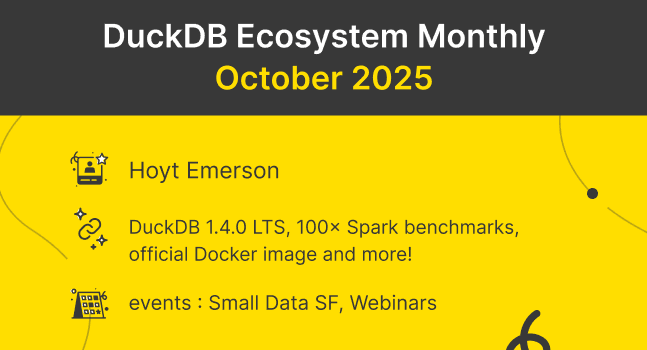DuckDB 1.4.1 and DuckLake 0.3 Land in MotherDuck: New SQL Syntax, Iceberg Interoperability, and Performance Gains
2025/10/09 - 5 min read
BYOne of the most exciting things about DuckDB as a technology is just how quickly it improves. It’s hard not to be excited about supporting a major release, but we are especially excited about this one. We’re thrilled to share that MotherDuck now supports DuckDB version 1.4.1 and DuckLake version 0.3.
DuckDB 1.4.0 introduced landmark features, including the MERGE statement, VARIANT type, and a completely rewritten sorting engine. DuckDB 1.4.1 builds on that foundation with important bugfixes and additional improvements. MotherDuck now supports the latest 1.4.1 version. While you can continue using your current version of DuckDB, we encourage you to upgrade your DuckDB clients to 1.4.1 as soon as you can.
On the DuckLake side, MotherDuck now supports DuckLake 0.3. DuckLake 0.3 introduces the DuckLake CHECKPOINT function that makes table maintenance automatic, plus interoperability with Iceberg and native support for spatial geometry types.
Read on for our favorite highlights from these releases, and check out the DuckDB blogs on 1.4.0 and 1.4.1 for all the details.
DuckLake 0.3: Iceberg Interoperability, Simplified Maintenance, and Spatial Data Support
Iceberg Interoperability
Thanks to the DuckDB iceberg extension, migrating your Iceberg data lake to MotherDuck-managed DuckLake just got a lot easier. On the migration path, you’ll find an integrated, cloud-scale lakehouse that maintains support for tools that only speak Iceberg.
You can now copy directly from Iceberg to DuckLake as part of a migration, or from DuckLake to Iceberg to continue using your favorite Iceberg-only tools.
DuckLake Checkpoint: Maintenance Made Easy
The new CHECKPOINT statement combines all the maintenance operations you need into a single, simple command. Configure it once, and it automatically runs operations in sequential order:
- Flushes inlined data
- Compacts small files created by multi-threaded writes
- Rewrites files with many deletions
- Cleans up orphaned files
No more juggling multiple maintenance commands—just call CHECKPOINT and DuckLake handles the rest:
Copy code
ATTACH 'ducklake:my_ducklake.ducklake' AS my_ducklake;
USE my_ducklake;
CHECKPOINT;
Spatial Geometry Types
DuckLake 0.3 introduces native support for geometry data types, allowing users to take advantage of the DuckDB spatial extension’s functionality in DuckLake. This opens up powerful new use cases for geospatial analytics directly on your data lake–see the DuckLake documentation for a list of supported types.
MERGE INTO: Upserts for Data Lakes
DuckLake 0.3 now fully supports the MERGE INTO statement, bringing elegant upsert capabilities to your data lake tables without requiring primary keys or indexes. This is a game-changer for incremental data pipelines and slowly changing dimensions.
As an example:
Copy code
-- Update existing records and insert new ones
WITH new_stocks(item_id, volume) AS (VALUES (20, 2200), (30, 1900))
MERGE INTO ducklake_table.Stock
USING new_stocks USING (item_id)
WHEN MATCHED THEN UPDATE SET balance = balance + volume
WHEN NOT MATCHED THEN INSERT VALUES (new_stocks.item_id, new_stocks.volume)
RETURNING merge_action, *;
MERGE also supports complex conditions and DELETE operations, making it perfect for real-world data engineering workflows. MERGE operations are efficient and work seamlessly with time travel, versioning, and all other DuckLake features. This gives you OLAP-optimized upsert performance on data lake storage:
Copy code
WITH deletes(item_id, delete_threshold) AS (VALUES (10, 3000))
MERGE INTO Stock USING deletes USING (item_id)
WHEN MATCHED AND balance < delete_threshold THEN DELETE;
FROM Stock;
Smarter Write Performance
DuckLake 0.3 speeds up write performance by allowing each thread to write separate files, which can be compacted later using the checkpoint function. This parallelization dramatically improves throughput for bulk inserts while keeping your table organized.
Additional DuckLake 0.3 Features
- Snapshot tracking: New
current_snapshot()function for easier snapshot management - Orphaned file cleanup: The
ducklake_delete_orphaned_files()function removes files no longer tracked by DuckLake. Includes adry_runparameter for testing - Intelligent data file rewriting: Automatically identifies and rewrites files with many deletions for optimal performance on your current snapshot
DuckDB 1.4: MERGE Statement, VARIANT Type, and Performance
MERGE INTO: Upserts Without Primary Keys
DuckDB 1.4.0 adds full support for the MERGE statement, giving you a clean, standard SQL way to handle upserts without requiring primary keys or indexes.
Here's a simple example:
Copy code
CREATE TABLE Stock(item_id INTEGER, balance INTEGER);
INSERT INTO Stock VALUES (10, 2200), (20, 1900);
WITH new_stocks(item_id, volume) AS (VALUES (20, 2200), (30, 1900))
MERGE INTO Stock
USING new_stocks USING (item_id)
WHEN MATCHED
THEN UPDATE SET balance = balance + volume
WHEN NOT MATCHED
THEN INSERT VALUES (new_stocks.item_id, new_stocks.volume)
RETURNING merge_action, *;
MERGE also supports complex conditions and DELETE operations, and it works seamlessly with DuckLake 0.3.
Blazing Fast Sorting: Rewritten from the Ground Up
DuckDB 1.4.0 introduced a completely new sorting implementation that delivers often 2x or better performance improvements while using significantly less memory and scaling better across multiple threads.
The new k-way merge sort reduces data movement, adapts to pre-sorted data, and powers not just ORDER BY clauses but also window functions and list sorting operations. Your most intensive analytical queries just got dramatically faster – read the DuckDB blog for more detail.
Additional SQL Features
VARIANT type for semi-structured data
The new VARIANT type provides fast processing of JSON and other semi-structured data, with support for reading VARIANT types from Parquet files, including shredded encodings.
FILL window function for interpolation
The new FILL() window function makes it easy to interpolate missing values:
Copy code
FROM (VALUES (1, 1), (2, NULL), (3, 42)) t(c1, c2)
SELECT fill(c2) OVER (ORDER BY c1) f;
-- Result: 1, 21, 42
Huge Thanks to the DuckDB Team and Community
It’s incredibly fun to work with a technology that improves so fast, and we’re so grateful to the entire DuckDB community. DuckDB 1.4 wouldn't be possible without the outstanding work from the DuckDB team and over 90 contributors who made more than 3,500 commits since version 1.3.2.
If you’re curious about what else shipped in 1.4, head on over to the DuckDB site and take a gander for yourself. And if you’d like to run DuckDB-powered analytics at cloud scale, spin up a free trial of MotherDuck or join our community Slack.
Let's get quacking! 🦆



